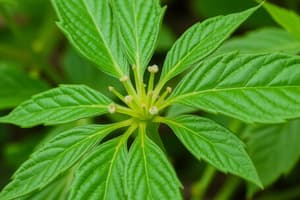Podcast
Questions and Answers
What is the initial product formed by plants during the process of photosynthesis?
What is the initial product formed by plants during the process of photosynthesis?
- Three-carbon organic acid (correct)
- Four-carbon organic acid
- Glucose
- Chlorophyll
Which type of plants exhibit C4 photosynthesis?
Which type of plants exhibit C4 photosynthesis?
- Roses
- Daisies
- Pine trees
- Corn (correct)
What is the main function of chlorophyll in photosynthesis?
What is the main function of chlorophyll in photosynthesis?
- Absorb water
- Capture sunlight (correct)
- Convert glucose into energy
- Produce oxygen
Why is C4 photosynthesis considered more efficient in warmer temperatures?
Why is C4 photosynthesis considered more efficient in warmer temperatures?
In which cellular machinery does photosynthesis take place?
In which cellular machinery does photosynthesis take place?
Apart from the food we eat, what else does photosynthesis provide us with?
Apart from the food we eat, what else does photosynthesis provide us with?
What is the primary purpose of photosynthesis in plants?
What is the primary purpose of photosynthesis in plants?
Where does photosynthesis primarily take place in a plant cell?
Where does photosynthesis primarily take place in a plant cell?
What are the main raw materials required for photosynthesis to occur?
What are the main raw materials required for photosynthesis to occur?
What is the primary function of chlorophyll in photosynthesis?
What is the primary function of chlorophyll in photosynthesis?
Which organelle contains chlorophyll and is crucial for the photosynthetic process?
Which organelle contains chlorophyll and is crucial for the photosynthetic process?
What is the final product of the Calvin cycle in photosynthesis?
What is the final product of the Calvin cycle in photosynthesis?
Flashcards are hidden until you start studying
Study Notes
Botany: The Art of Understanding Plants
At the heart of every vibrant forest, sprawling meadow, and lush garden lies the intricate dance of botany, the study of plants and their interactions with the natural world. One fundamental process that drives this dance is photosynthesis, a marvel of plant biology.
Photosynthesis: The Power of Light
Photosynthesis is a chemical process through which plants, algae, and some bacteria convert sunlight, water, and carbon dioxide into glucose and oxygen, releasing energy in the form of heat in the process. This energy is then used by plants to grow and reproduce.
The photosynthetic process begins in the cell's chloroplast, a specialized organelle containing chlorophyll and other pigments. In the presence of sunlight, these pigments absorb light energy and transfer it to specialized proteins called reaction centers. These centers then convert the captured light energy into chemical energy in the form of ATP (adenosine triphosphate) and NADPH (nicotinamide adenine dinucleotide phosphate).
As the sun's light continues to fuel the process, the plant uses CO₂ and water to form glucose in the Calvin cycle, releasing oxygen as a waste product. The glucose, a simple sugar, can be used by the plant for energy or stored for later use.
Types of Photosynthesis
There are two main types of photosynthesis: C3 and C4.
-
C3 photosynthesis is the most common type, occurring in plants like wheat, rice, and soybeans. In this process, the plant uses the initial CO₂ taken in to form a three-carbon organic acid, which is later converted into glucose.
-
C4 photosynthesis occurs in plants like corn, sugarcane, and sorghum. In this process, the plant first captures CO₂ in a four-carbon organic acid, which is then converted into three-carbon compounds and eventually glucose. This type of photosynthesis is more efficient in warmer temperatures and helps plants conserve water.
Chloroplasts: The Engine of Photosynthesis
Chloroplasts are the cellular machinery responsible for photosynthesis. They contain chlorophyll, the green pigment that absorbs sunlight, along with other pigments such as carotenoids, which absorb light in wavelengths that chlorophyll does not. These pigments are organized into two light-harvesting complexes, LHC I and LHC II, which work together to maximize the absorption of light energy.
Chloroplasts also contain the enzymes and proteins necessary to convert this light energy into chemical energy. The two main types of chloroplasts are prokaryotic and eukaryotic. Prokaryotic chloroplasts are found in cyanobacteria, while eukaryotic chloroplasts can be found in algae and plants.
The Importance of Photosynthesis
Photosynthesis is a critical process in maintaining the health and stability of our planet. It provides us with oxygen and the food we eat, and it is an essential part of the global carbon cycle, which helps regulate the Earth's climate. Photosynthesis also produces the plant biomass that underpins the food chain, providing energy and nutrients for other living organisms.
In addition, photosynthesis is a potential source of renewable energy. By harnessing solar energy, scientists hope to develop clean and sustainable ways to produce electricity, fuel, and other energy-related products.
Conclusion
As you can see, photosynthesis is a complex and multifaceted process, critical to the health and functioning of our planet. By understanding this process, we can better appreciate the intricate dance of botany, and the many ways in which plants and their ecosystems support and sustain life on Earth.
[Sources: The information presented in this article is commonly taught in schools, colleges, and universities, and is widely available in multiple botany textbooks such as "Botany: An Introduction to Plant Biology" by Paul E. Berry and "Plant Biology" by Donald F. Currah and Daniel I. McCahan. The details and terminology used are also consistent with the National Science Education Standards for Life Science and the Advanced Placement Biology Curriculum Framework.]
Studying That Suits You
Use AI to generate personalized quizzes and flashcards to suit your learning preferences.




